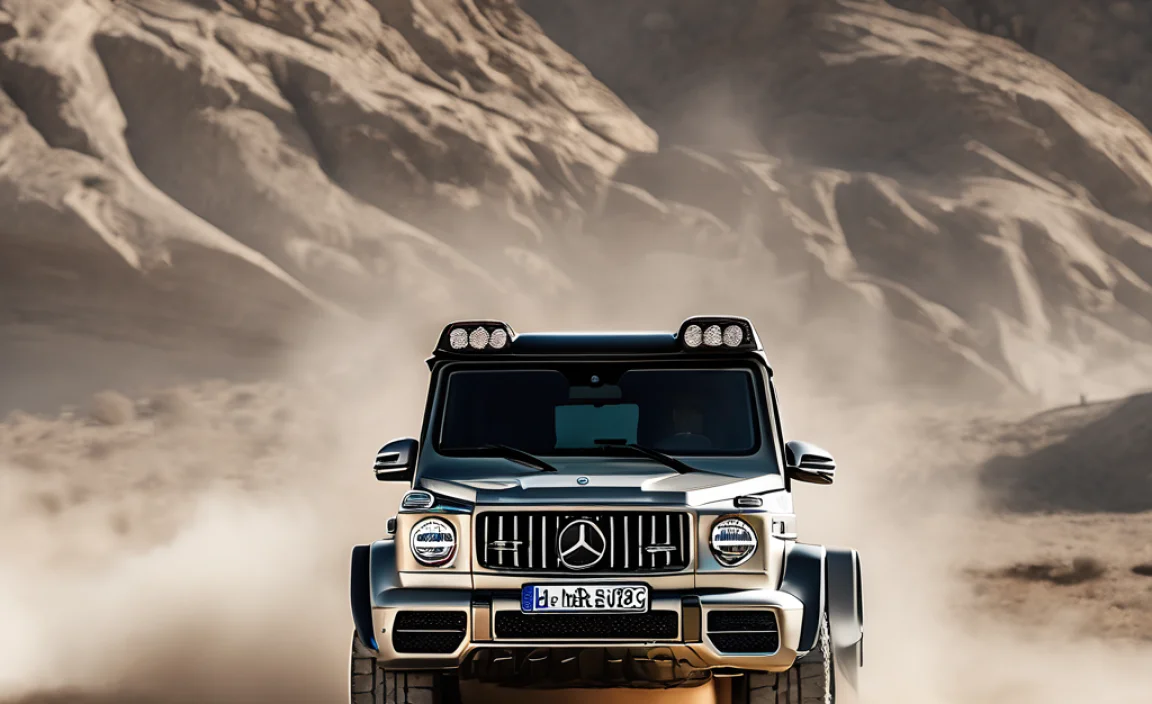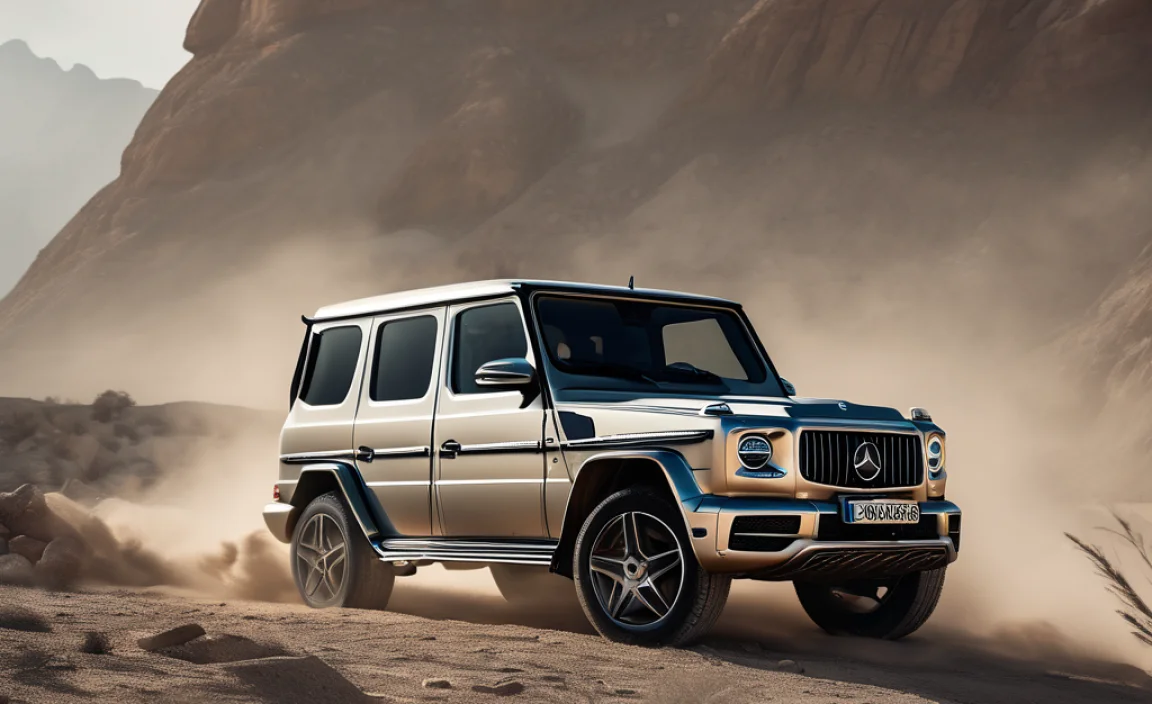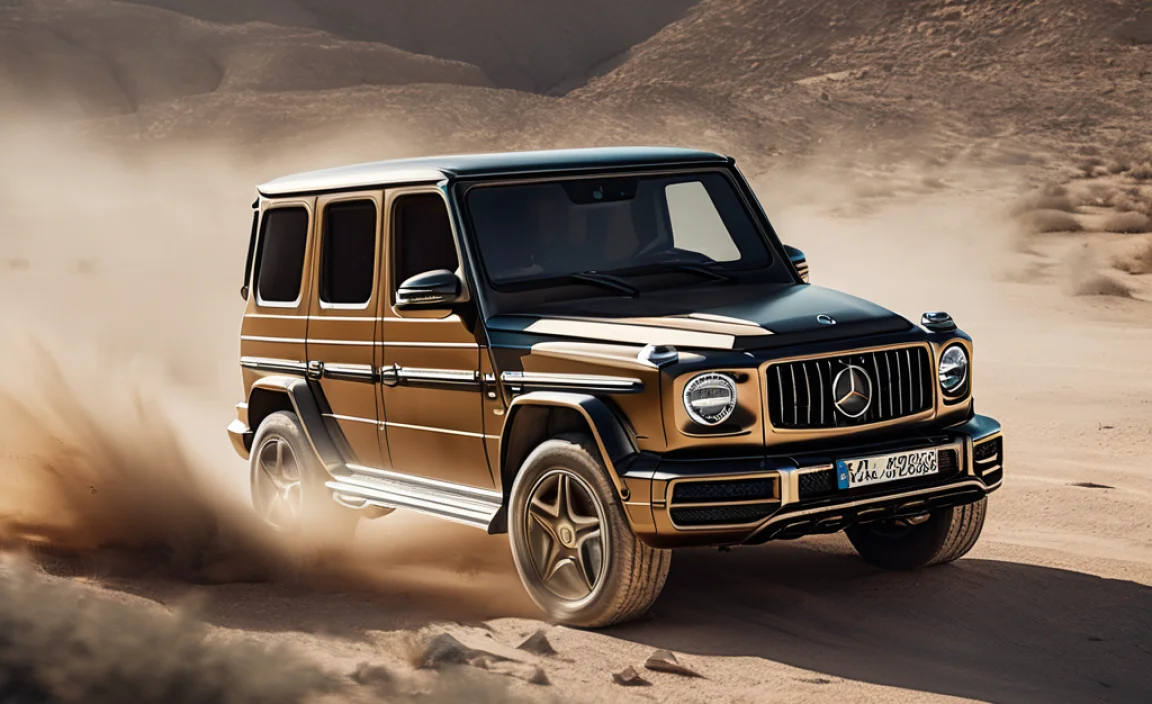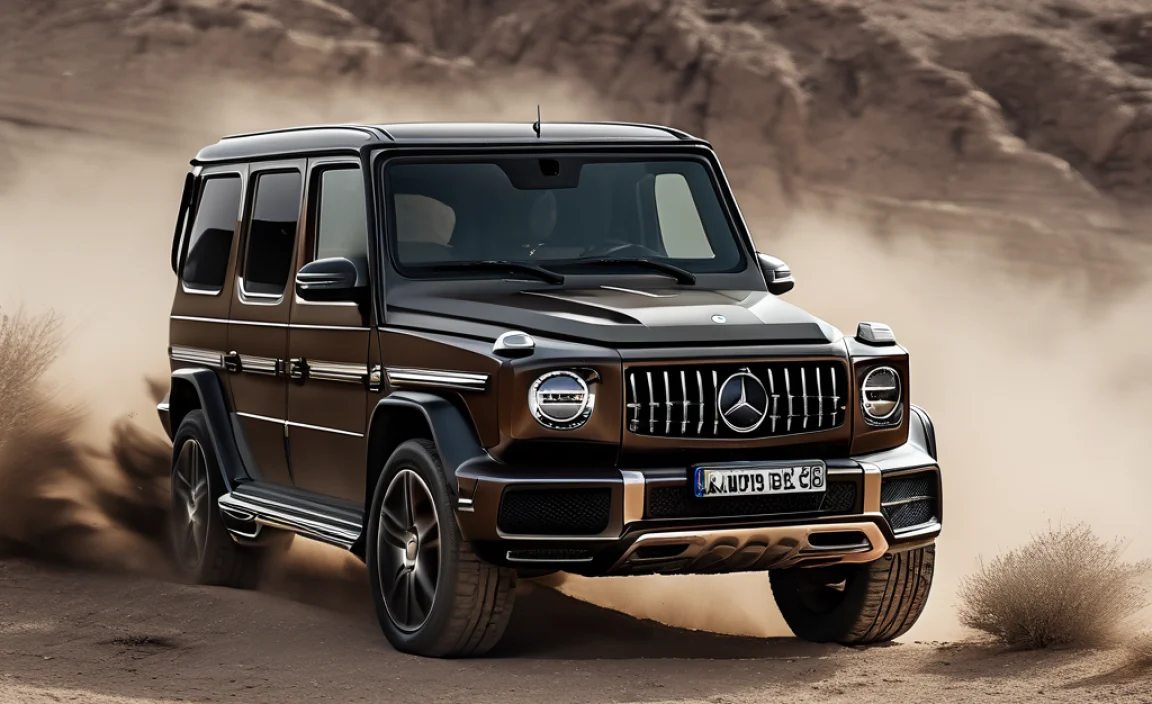Think Mercedes G-Class means city streets? The Caracal Air Assault Vehicle drops from helicopters. It charges through deserts with purpose and power. What is the Mercedes G-Class Caracal?
Born from the DNA of the iconic Mercedes-Benz G Class, the Caracal Tactical Vehicle isn’t just a military version—it’s a complete reimagining of what a battlefield SUV should be. ACS Armoured Car Systems and Rheinmetall Caracal teamed up with Mercedes-Benz AG to build the Caracal. It’s designed to fly, fight, and adapt on the move.
Whether you’re a defense strategist, a gearhead, or just someone curious about military innovation, this story goes way beyond six wheels and matte paint. It’s about how one machine is changing the way nations move and fight.
Overview Of The Caracal Air Assault Vehicle

You know how some vehicles are built to impress, and others are built to endure? The Caracal Air Assault Vehicle manages to do both—and more. At first glance, it might remind you of a Mercedes G-Class, but look again. This isn’t your regular off-roader—it’s a Caracal Tactical Vehicle, purpose-built for special forces, rapid deployments, and frontline adaptability.
Designed by ACS Armoured Car Systems in partnership with Rheinmetall Caracal, this machine was made for action. It’s not just a car—it’s a mission-ready solution.
Design And Structure

The Caracal wears its intentions on its skin.
With its modular superstructure, the vehicle easily adapts to different roles. It can serve as a reconnaissance unit, a command center, or an infantry transporter. Its dimensions are compact but functional, optimizing the available wheelbases to support rapid configuration changes and specific mission needs.
The rigid axles ensure extreme durability under pressure, while its low-profile frame and 4900 kg weight keep it light enough for air transport yet strong enough to take a beating.
Airmobility Features

What truly sets the Caracal apart is its airmobility. These are airborne Caracal vehicles, designed to be transported under helicopters or inside cargo planes.
Need to insert a basic troop carrier into a remote area fast? Caracal’s got you. With underslung cargo capabilities and compatibility with medium-lift aircraft, it brings new meaning to rapid response.
Whether in deserts, forests, or snowy trenches, the Caracal moves with troops—not behind them.
Engine Performance

Under the hood, the Caracal doesn’t shy away from power.
It delivers 183 kW (that’s 249 hp) and plenty of torque to handle off-road abuse. Think rough terrain, steep inclines, and high-speed pursuit over uneven ground—all managed with ease.
And despite its power, it’s fuel-conscious, offering better fuel efficiency than heavier traditional vehicles in its class.
Comparison With Mercedes-Benz G-Class

Let’s pause and compare.
The Mercedes-Benz G-Class, especially models from Mercedes-Benz AG, delivers luxury and dominates the road. In contrast, the Caracal focuses on practicality and protection. While the G-Class shines in the civilian world, the Caracal goes where a Mercedes-Benz C-Class—or even an AMG G63—won’t dare venture. But the DNA? That rugged spirit? It’s all there.
Street Prowess Vs. Military Robustness
Sure, a G-Wagen looks good on Rodeo Drive. But the military version of the Caracal is made for the battlefield.
The G-Class offers street comfort; the Caracal is all about survival. It can handle a fording depth most SUVs wouldn’t even approach. Add in the modular setup, and it can switch from transport to weapon systems in a matter of minutes.
One’s a legend in pop culture. The other’s a rising icon in military users’ arsenals.
Operational Capabilities
The Caracal isn’t just about getting from A to B.
It’s designed for reconnaissance, high-speed patrols, and direct combat support. With a high payload capacity, troops can load it with gear, weapons, or specialized equipment and still move at speed.
Its agility is unmatched—tight turns, rugged climbs, and fast acceleration on unstable surfaces. You name it, the Caracal does it.
Specialized Armaments
Weapon options? Oh, the Caracal doesn’t hold back.
Equipped to carry standard infantry weapons, ATGM weapons, and launchers, it offers real combat value. One version even supports a ring mount or quadruple bank of grenades.
This isn’t just a people mover. It’s a mobile weapons platform.
Armor Specifications
Let’s talk protection.
The Caracal comes with customizable armor. The Caracal adapts to mission needs by adding armor to resist small arms fire, shrapnel, or IED blasts. It stays light enough for airlift, even with added protection.
The unique modular design means you can bolt on extra armor or defensive systems when needed—making it as flexible as it is fierce.
Operational Variants
There’s no “one-size-fits-all” here.
The Caracal comes in several operational variants. Some are basic troop carriers, others are reconnaissance vehicles, command nodes, or anti-tank platforms.
Thanks to its modular superstructure, the team can easily swap between configurations. It’s built to adapt quickly to changing threats and diverse roles.
Role In Dutch Military Projects
The Netherlands is betting big on the Caracal.
The Dutch military has chosen the Caracal Air Assault Vehicle for its next-gen mobile units. They’re using it to modernize rapid-response strategies and strengthen light infantry capabilities.
It’s not just a tool—it’s a central component in their strategic shift toward agility and mobility.
Significance In Replacement Initiatives
Many NATO allies are looking to retire older, heavier models. And the Caracal is a prime candidate in these replacement initiatives.
Why? Because it offers the best of both worlds: modern combat readiness and operational flexibility, backed by proven engineering from Armoured Car Systems and Rheinmetall Caracal.
Procurement Process
The Caracal is already undergoing series production, with full scale production expected to increase in 2025.
Selected militaries are now receiving serial production models, following successful testing and evaluations. Manufacturers are delivering these vehicles through structured procurement phases. Every delivery comes with tailored modifications based on user feedback and operational climate.
Operators Of The Caracal
Current Global Operators
The Caracal is already in service with several European nations, including the Netherlands and potentially select Baltic states.
They’ve chosen it for its ability to support special forces, blend into urban or rural terrain, and integrate advanced weapon systems within a small, agile frame.
Potential Future Operators
Eyes are on the Caracal from across the globe.
Nations with rapid-deployment goals—especially in the Middle East, Southeast Asia, and Africa—are exploring its fit for light infantry roles, border patrol, and airborne divisions.
And as NATO members modernize, the Caracal is showing up on more radars.
Caracal In The Context Of Military Innovation
The Caracal isn’t just a product—it’s part of a movement.
Its success shows a shift in military strategy. It’s not always about armor that can take a missile. Sometimes, it’s about getting there fast, hitting hard, and getting out safely.
It fits into the growing image of mobility-focused modern warfare—where drones fly overhead, troops move fast, and machines like the Caracal carry the fight forward.
Synergy With Civilian Automotive Innovations
Now here’s where things get really interesting.
There’s real synergy between the Caracal and what we see in the civilian world. Elements of EQ Technology, modular platforms, and efficient fuel economy systems have roots in consumer innovation from companies like Mercedes-Benz AG.
Even the Caracal’s electronic assist systems echo features we see in vehicles like the Mercedes-Benz C Class and Mercedes-Benz G500—blurring the line between luxury SUV and military beast.
Comparison With Renault Rafale Armored Crossover
When it comes to tactical mobility, both the Caracal Air Assault Vehicle and the Renault Rafale Armored Crossover offer distinct strengths. But their core missions, design philosophies, and battlefield readiness couldn’t be more different.
The Rafale focuses on hybrid mobility and sleek styling. In contrast, the Caracal embraces a rugged design. Engineers built it for full-scale deployments, rapid insertion, and high-stress military operations.
Payload Capacity And Airmobility
The Caracal Tactical Vehicle offers a clear advantage in payload capacity. Designed to carry heavy gear, standard infantry weapons, or even integrated ATGM weapons and launchers, it doesn’t sacrifice agility for weight.
Meanwhile, the Rafale operates within stricter limits. The Rafale doesn’t support external underslung cargo transport effectively. Its structure limits the kind of airmobility that special forces require. In contrast, crews can quickly load the Caracal onto medium-lift helicopters or military transport planes. This makes it a vital asset for deploying airborne Caracal vehicles directly into combat zones.
Modular Design Vs. Fixed Architecture
A key strength of the Caracal lies in its unique modular design. It supports multiple operational variants, adapting to roles like reconnaissance, basic troop carrier, or mobile weapon systems with ease. Swapping configurations between missions is seamless, thanks to its modular superstructure and flexible available wheelbases.
In contrast, the Rafale has a more fixed platform. While it may offer some customization, it lacks the field-level adaptability that makes the Caracal such a standout in evolving combat conditions.
Combat-Ready Vs. Patrol-Oriented
The Rafale is well-suited to urban patrols and hybrid reconnaissance, but its utility in high-threat environments is limited. It’s more of a strategic presence than a frontline performer.
The Caracal, by contrast, is made for combat. Its robust rigid axles, high torque, deep fording depth, and battlefield mobility make it ideal for crossing trenches, scaling rough terrain, and surviving hostile environments. This vehicle doesn’t just look military—it acts military.
Weapon Systems And Armament Options
When it comes to firepower, the Caracal doesn’t hold back.
It’s compatible with ring mounts, quadruple bank grenade systems, and a range of weapon systems that transform it into a mobile combat base. These aren’t theoretical capabilities—they’re tested in live exercises and integrated into procurement requirements by active military users.
The Rafale, while innovative, offers more limited armament options and is not currently fielded with the same degree of real-world service or combat feedback.
Production And Real-World Deployment
The Caracal is already in serial production, with active units in deployment across Europe. It’s passed through rigorous procurement phases and is moving toward full scale production, with delivery already underway to key partners like the Dutch Armed Forces.
The Renault Rafale, though promising on paper, remains more of a concept or limited-scope platform, yet to reach the series production momentum or battlefield credibility of the Caracal.
Conclusion
The Mercedes G-Class Caracal is more than a tactical vehicle—it’s a blueprint for the future of mobile warfare.
It combines the reliability and off-road genius of the G-Wagen legacy with modular innovation, airlift capabilities, and frontline adaptability. From its high payload capacity to its mission-specific weapon systems, the Caracal delivers where many platforms only promise.
With proven performance, active series production, and growing global interest, the Caracal is rapidly becoming the benchmark in its class. Whether it’s rolling through trenches, being hoisted as underslung cargo, or leading a reconnaissance mission, this vehicle isn’t just in service. It’s redefining service.
FAQs
What Is The Mercedes G-Class Caracal?
The Caracal Air Assault Vehicle is a military-grade, highly mobile tactical platform based on Mercedes-Benz G Class engineering. It’s designed for special forces, rapid deployment, and airborne missions.
Who Manufactures The Caracal?
The Caracal Tactical Vehicle is a result of a collaboration between ACS Armoured Car Systems, Rheinmetall Caracal, and Mercedes-Benz AG. It’s currently in series production and full scale production phases.
What Are The Key Features Of The Caracal?
The Caracal features a modular superstructure, rigid axles, airlift capability via underslung cargo, 183 kW power output (249 hp), advanced weapon systems, and high payload capacity of up to 4900 kg.
Is The Caracal In Active Service?
Yes. The Caracal is currently used by multiple military users, including Dutch forces, and is a key component in ongoing replacement initiatives across Europe.
How Does The Caracal Compare To The Renault Rafale?
While the Renault Rafale Armored Crossover offers hybrid mobility, the Caracal outperforms it in combat-readiness, airmobility, payload, and proven battlefield use.